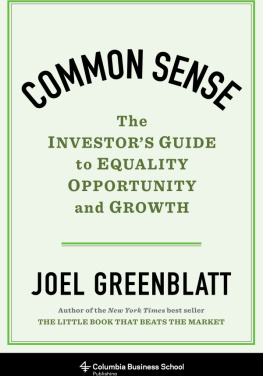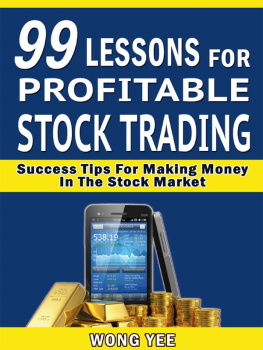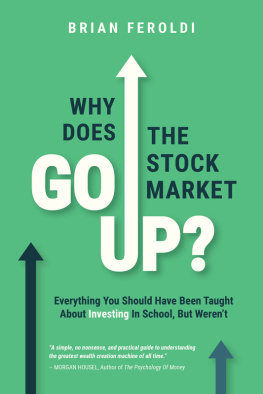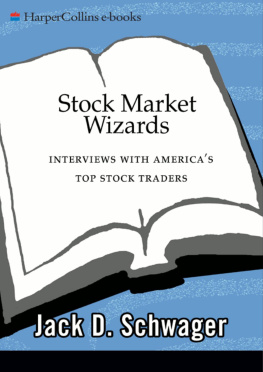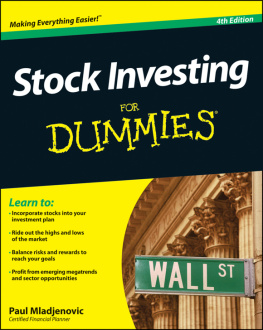Table of Contents
Copyright 2010 by Joel Greenblatt. All rights reserved
Published by John Wiley & Sons, Inc., Hoboken, New Jersey
Published simultaneously in Canada
No part of this publication may be reproduced, stored in a retrieval system, or transmitted in any form or by any means, electronic, mechanical, photocopying, recording, scanning, or otherwise, except as permitted under Section 107 or 108 of the 1976 United States Copyright Act, without either the prior written permission of the Publisher, or authorization through payment of the appropriate per-copy fee to the Copyright Clearance Center, Inc., 222 Rosewood Drive, Danvers, MA 01923, (978) 750-8400, fax (978) 750-4470, or on the web at www.copyright.com. Requests to the Publisher for permission should be addressed to the Permissions Department, John Wiley & Sons, Inc., 111 River Street, Hoboken, NJ 07030, (201) 748-6011, fax (201) 748-6008, or online at http://www.wiley.com/go/permissions.
Limit of Liability/Disclaimer of Warranty: While the publisher and author have used their best efforts in preparing this book, they make no representations or warranties with respect to the accuracy or completeness of the contents of this book and specifically disclaim any implied warranties of merchantability or fitness for a particular purpose. No warranty may be created or extended by sales representatives or written sales materials. The advice and strategies contained herein may not be suitable for your situation. You should consult with a professional where appropriate. Neither the publisher nor author shall be liable for any loss of profit or any other commercial damages, including but not limited to special, incidental, consequential, or other damages.
For general information on our other products and services or for technical support, please contact our Customer Care Department within the United States at (800) 762-2974, outside the United States at (317) 572-3993 or fax (317) 572-4002.
Wiley also publishes its books in a variety of electronic formats. Some content that appears in print may not be available in electronic books. For more information about Wiley products, visit our web site at www.wiley.com.
ISBN 978-0-470-62415-9 (cloth); 978-0-470-92671-0 (ebk);
978-0-470-92672-7 (ebk)
To my wonderful wife, Julie, and our five magnificent spin-offs
Acknowledgments

I AM GRATEFUL TO THE MANY FRIENDS, colleagues, and family who have contributed to this project. In particular, special thanks are due to my partners at Gotham Capital, Rob Goldstein and John Petry. Not only are they the true coauthors of the Magic Formula study that appears in this book, but it is also a rare privilege to be associated with such brilliant, talented, and generous people. Their contributions to this bookand to the success of Gotham Capitalcannot be overstated and are appreciated more than they know. I would also like to give special thanks to Edward Ramsden at Caburn Capital for his extraordinarily insightful comments, suggestions, and editing work; to Norbert Lou at Punchcard Capital, particularly for his inspiration and suggestions for Chapter 9; and to Patrick Ede at Gotham Capital for his major contributions to the Magic Formula study, for his intelligent and helpful comments, and for his editing talents. In addition, my brother, Richard Greenblatt at America Capital, deserves a major part of the credit for being my editor-at-large, for his many good ideas, for his numerous contributions to each chapter, and especially for his encouragement with this project and throughout my life.
I am also grateful for the many helpful contributions and inspiration provided by Dr. Sharon Curhan (my sister, and my favorite artist), Dr. Gary Curhan, Joshua Curhan, Justin Curhan, Linda Greenblatt Gordon at Saddle Rock Partners, Michael Gordon, Bryan Binder at Caxton Associates, Dr. Susan Binder, Allan and Mickey Greenblatt (my wonderful parents), Dr. George and Cecile Teebor (the famous in-laws), Ezra Merkin at Gabriel Capital, Rod Moskowitz, John Scully, Marc Silbert, David Rabinowitz at Kirkwood Capital, Larry Balaban, Rabbi Label Lam, Eric Rosenfeld at Crescendo Partners, Robert Kushel (my broker at Smith Barney), Dan Nir at Gracie Capital, Brian Gaines at Springhouse Capital, Bruce Newberg (who got me started), Matthew Newberg, Rich Pzena at Pzena Investment Management, and Adam Barth, David Pecora, and Yury Kholondyrev at Gotham Capital. Special thanks to David Pugh, my editor at John Wiley, and Sandra Dijkstra, my literary agent, for their encouragement and enthusiastic support of this project. Thank you also to Andrew Tobias for graciously writing the foreword and for being a good friend.
I would also like to thank my two oldest children, Matthew and Rebecca Greenblatt, for being willing students and readers (and for laughing at most of the jokes). To my three youngest children, Melissa, Jonathan, and Jordan, thank you for your inspiration. And to all the kids, thank you for the joy you bring each day. Thank you also to my beautiful wife, Julie, for her sage advice with this book, and in life, for her love and support and for each precious day together.
Foreword
THE BEST THING ABOUT THIS BOOKfrom which I intend to steal liberally for the next edition of The Only Investment Guide Youll Ever Need is that most people wont believe it. Or, believing it, wont have the patience to follow its advice. Thats good, because the more people who know about a good thing, the more expensive that thing ordinarily becomes... bye-bye bargain.
Yet unlike most systems meant to exploit anomalies in the market, Joel Greenblatts simple notion will likely retain at least a good deal of its validity even if it becomes widely followed.
I dont want to spoil the surprisethe book is short enough as it is. My role here is simply to introduce you to the author, so you have some sense of just how far you can trust him.
Ive known Joel for decades. He is really smart, really modest, really well intentioned, andhere is the unusual partreally successful. (I mean: really successful.)
More to the point, his success has come from shrewd investing (not from selling books).
He is also funny. I read the first couple of chapters of this book to my 11-year-old nephew, Timmy, and we both enjoyed it. Timmy, with no investable funds that I know of, then fell asleep as I raced to the end, mentally rejiggering my retirement plan.
Let me tell you this much: In the beginning, there were mutual funds, and that was good. But their sales fees and expenses were way too high. Then came no-load funds, which were better. They eliminated the sales fee, but were still burdened with management fees and with the tax and transactional burden that comes from active management. Then came index funds, which cut fees, taxes, and transaction costs to the bone. Very, very good.
What Joel would have you consider, in effect, is an index-fund-plus, where the plus comes from including in your basket of stocks only good businesses selling at low valuations. And he has an easy way for you to find them.
Not everyone can beat the averages, of courseby definition. But my guess is that patient people who follow Joels advice will beat them over time. And that if millions of people should adopt this strategy (Vanguard: please hurry up and offer a low-priced fund like this), two things will happen. First, the advantage of investing this way will diminish but not disappear. Second, stock market valuations will become ever so slightly more rational, making our capital allocation process ever so slightly more efficient.


